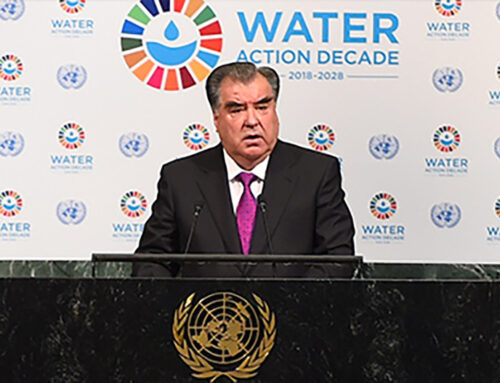
The construction of the Rogun dam has long been a hot topic in the region. Feasibility studies began in the 1970’s and since then the project has been under international investigation and scrutiny. Today, it is quite apparent that the project is not only ecologically sound, it will effectively increase energy output to cover not only Tajikistan’s domestic demands, but also those of other countries of the region, where an acute shortage of electricity power is experienced during the winter period over the last years. Production of cheap and ecologically clean energy will also allow to have additional resources to develop the economy and increase the overall welfare of the population of Central Asian countries.
However, opposition to the project remains fierce. In a recent article published in the Uzbek government newspaper “Narodnoe Slovo” (“the Word of the People”), it was alleged that the leadership of Tajikistan and Kyrgyzstan, with the construction of the Rogun HPP and the multiple Kambarata HPPs, are not concerned with the safety of the surrounding population. Potential dangers and ecological damage read like a laundry list: the construction of the Rogun reservoir and its operation within the energy system will adversely affect the supply of fresh water to the people living downstream.
It will not be possible to store fresh water in the Kaparasskom reservoir and the irrigation of the Uzbek farmland will be affected due to the decrease of the water release from the water reservoir. Furthermore, the high seismic activity of the location will expose the locals to the threat of earthquakes.
These concerns are in fact quite far from reality. All issues including seismicity and geology conditions of the site had been taken into account during the original design phase. Through the current feasibility study supported by the World Bank, any outstanding issues are being revised once again within the study. The Rogun project aims to bring power to the people in the entire region and at the same time step up water management, which will in turn improve agricultural output.
Additionally, the project takes into account the interest of all riparian countries on water demand within existing rules and limits of water (approved by ICWC, the Interstate Commission for Water Coordination). These points are included in the feasibility study of the Rogun project.
As it stands, Tajikistan has no other resources such as gas or oil to ensure the economic growth of the country. However, any suggestion that Tajikistan has only self interest in mind is false. Tajikistan plans to implement the project taking fully into account the interests of all riparian countries. It may be that Uzbek experts think that Tajikistan will increase winter energy output, which in turn affects the amount of water released from water reservoir in the summer period. But this is not the case, as the Tajik side states its willingness not to violate the rules and limits of ICWC. But if we take into account the fact that in future Tajikistan will be a part of the CASA 1000 project then the water release from the reservoir in the summer will be increasing to generate more electricity to export to Afghanistan and Pakistan. In this case, downstream countries like Uzbekistan will actually receive more water in the summer.
As it is expected that Rogun will not change the river flow, there will be no difficulty in filling the Kaparass reservoir during the winter. Even if the winter flow will increase, it will allow to fill the Kaparass reservoir during the winter, when water in Amudarya river is not polluted. It should be noted that water flowing from Tajikistan to Uzbekistan by Amudarya has good quality. Currently, the Amudarya is being polluted mainly by Uzbek farmers, as irrigation areas of Uzbekistan make up more than 50% of the Amudarya basin irrigation lands. It is a great exaggeration that increasing salinity leads to complete failure of the drinking water infrastructure. None of the studies have shown a need to spend additional funds to construct new water facilities. In fact, it is the responsibility of Uzbekistan to practice better water and irrigation management.
The obligation to cooperate is one of the principles in the International Water Convention, to which Uzbekistan is party. Despite not being a party to the convention, Tajikistan fully follows the requirements. In addition to the World Bank supported feasibility study, Tajikistan has also had two consultation meetings with riparian countries. Unfortunately Uzbekistan did not participate in these meetings and has instead chosen to ignore them. The time has come for open dialogue and careful review of the facts in a scientific and logical manner. The Rogun project stands to provide safe and abundant energy not only to Tajikistan but also to the region at large.
Thieu Cuypers,
President of Information and
Consulting Company “Big Media Group”,
Brussels, Belgium





